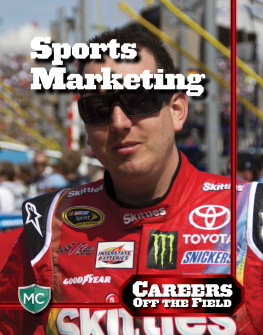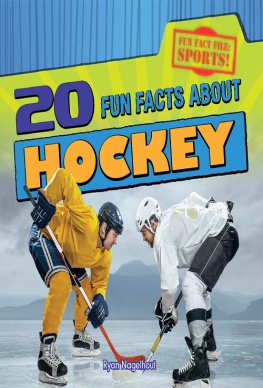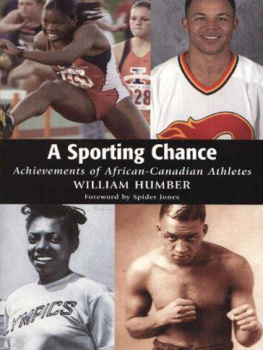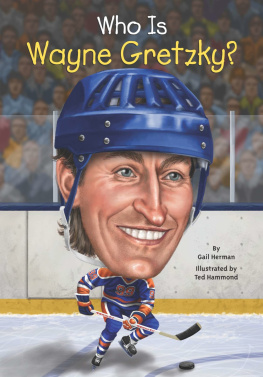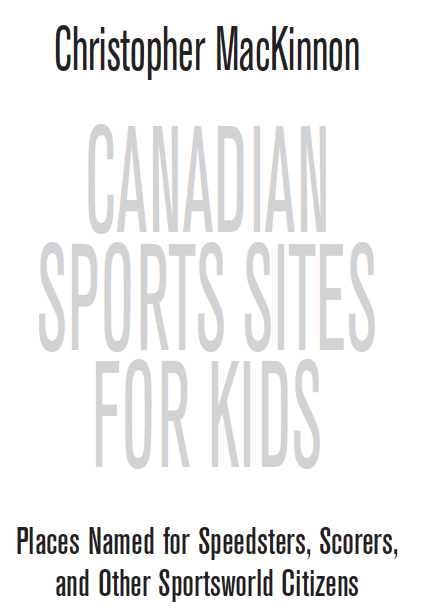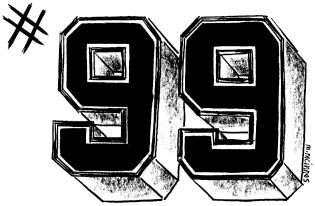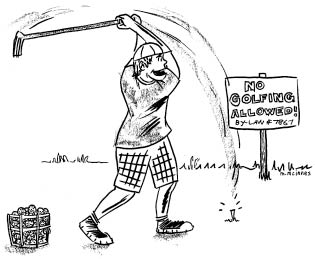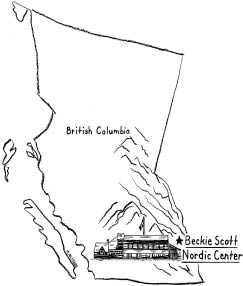Copyright
Copyright Christopher MacKinnon, 2012
All rights reserved. No part of this publication may be reproduced, stored in a retrieval system, or transmitted in any form or by any means, electronic, mechanical, photocopying, recording, or otherwise (except for brief passages for purposes of review) without the prior permission of Dundurn Press. Permission to photocopy should be requested from Access Copyright.
Editor: Allison Hirst
Design: Courtney Horner
Epub Design: Carmen Giraudy
All illustrations by Matt McInnes
Library and Archives Canada Cataloguing in Publication
MacKinnon, Christopher, 1978
Canadian sports sites for kids [electronic resource] : places named for speedsters,
scorers, and other sportsworld citizens / by Christopher MacKinnon.
Electronic monograph in multiple formats.
Issued also in print format.
ISBN 978-1-4597-0707-8
1. Names, Geographical--Canada--Juvenile literature. 2. Sports-
Miscellanea--Juvenile literature. I. Title.
FC36.M23 2012 j917.1'0014 C2012-904615-9
We acknowledge the support of the Canada Council for the Arts and the Ontario Arts Council for our publishing program. We also acknowledge the financial support of the Government of Canada through the Canada Book Fund and Livres Canada Books, and the Government of Ontario through the Ontario Book Publishing Tax Credit and the Ontario Media Development Corporation.
Care has been taken to trace the ownership of copyright material used in this book. The author and the publisher welcome any information enabling them to rectify any references or credits in subsequent editions.
J. Kirk Howard, President
Visit us at: Dundurn.com
Definingcanada.ca
@dundurnpress
Facebook.com/dundurnpress
Dedication
For Aidan and George
Acknowledgements
I would like to give a special nod to illustrator Matt McInnes, whose imaginative maps and drawings of Canadas sports geography are a key contribution to this book.
Many thanks as well to Colleen MacKinnon and Mark McInnes of St. Catharines, Ontario, who provided encouragement and early feedback on the manuscript. Thanks also to Jordon Vinette of the Planning, Property and Development Department at the City of Winnipeg for putting me in touch with Mr. Liggins. Athletic geographers Francis Treblesmith, Leslie Gaines, and Brenda Stairs took an early interest in the book. I thank them for their support and insightful comments. Sporting landscapers Lisa Jaynes, Thomas Grocer, and Joel Stackhouse also provided useful advice and game plan ideas along the way.
Introduction
Canadians are curious about place names. Especially the odd-sounding ones like Head-Smashed-In Buffalo Jump (Saskatchewan) and Punkeydoodles Corners (Ontario). Theres even an entire branch of our national government dedicated to cataloguing every place name in Canada.
But towns, rivers, and mountains arent the only features that need names. Parks, streets, and buildings require them, too. And since we Canadians love our sports, weve named lots of these places after stars from the sports world. Many athletes who have won trophies and prizes say their proudest moment wasnt when they scored an important goal or made a game-winning catch, it was when a street or school was named in their honour. In Canada, sports isnt just entertainment; its literally part of the landscape.
I started counting player place names as a kid growing up in Ontario. I lived near the hometown of Wayne Gretzky, the greatest scorer in NHL history, and I remember often seeing the big green sign on the road pointing to a place called Wayne Gretzky Parkway. Ive since added more than 250 places to my list and, all these years later, Im still counting.
Canadian Sports Sites
Number 99
Wayne Gretzky, the greatest goal-scorer in NHL history, is often referred to simply as Number 99. Gretzky wore number 99 on his jersey his entire career and a story circulates to this day that his original contract with the Oilers was for an incredible 99 years. The Ontario Hockey League even has a trophy called the Wayne Gretzky 99 Award, given each year to the leagues playoff MVP. So in what year did the city of Edmonton decide to rename one of its major streets Wayne Gretzky Drive ? In 1999, of course.
Fore!
On April 13, 2004, the mayor of Sarnia held a special outdoor ceremony to officially name a city park in honour of champion Canadian golfer Mike Weir. The site for Mike Weir Park was chosen because its where Mike practised hitting golf balls as a kid even though he knew it was against the law.
At the ceremony that day, the assembled crowd chuckled as mayor Mike Bradley presented Weir with a sign formerly posted at the park. It read: HITTING OF GOLF BALLS PROHIBITED. BY-LAW #7867 .
The Longest Gold Medal Race in History
By kindergarten, every kid knows that cheating is wrong. Too bad some grownup athletes sometimes forget that simple lesson. At the 2002 Olympic Winter Games in Salt Lake City, two Russian skiers learned their lesson the hard way.
On February 15, Canadians had watched with pride as Beckie Scott of Alberta already the namesake of the Beckie Scott Nordic Centre in Invermere, British Columbia won a hard-fought bronze medal in the womens five-kilometre pursuit. A couple of amazingly fast skiers from Russia took the gold and silver medals.
But just days later, the International Olympic Committee (IOC) revealed to the world that the two skiers whod finished ahead of Scott had tested positive for a performance-enhancing drug called darbepoetin. Thats against the rules, the Canadian Olympic Committee (COC) pointed out. The IOC agreed two years and four months later! With the Russians now disqualified, a patient Beckie Scott was upgraded to the gold medal she deserved.
Hundreds of people came out to the Vancouver Art Gallery on June 24, 2004, to see Beckie Scott finally receive her gold medal. It may be the longest gold medal race in history, but we won and we are thrilled to present Beckie with her well-deserved and long overdue gold medal, said COC president Michael Chambers.
Two years later, Scott won a silver medal with teammate Sara Renner in the team sprint event at the 2006 Olympics in Turin.


